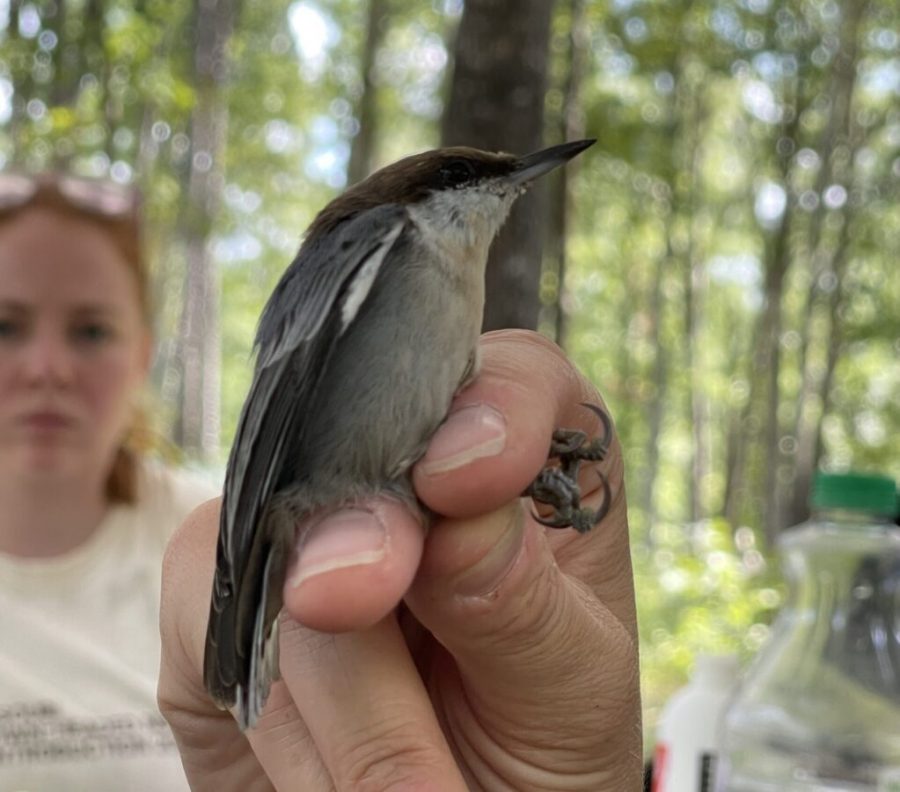In total, 56 Brown-headed Nuthatches were translocated to Missouri’s Mark Twain National Forest from the Ouachita National Forest in Arkansas between August and September of this year as part of the Missouri Department of Conservation’s (MDC) effort to reintroduce the bird species to the state, Sarah Kendrick, state ornithologist with the MDC, said. The reintroduction plan commenced in 2020, bringing 102 of the once extirpated birds to Missouri throughout the last two years.
The bird disappeared from Missouri in the early 1900s, after six million acres of shortleaf pine, the nuthatch’s natural habitat according to the American Bird Conservancy, were logged in southern Missouri in the late 1800s and early 1900s.
Kendrick coordinated the reintroduction with two others at the University of Missouri—Columbia and the U.S. Forest Service northern research center. She said the process took immense cooperation from groups such as the Fish and Wildlife Service, and the Arkansas Game and Fish Commission, along with support from individuals involved with Brown-headed Nuthatch reintroduction in states like Florida.
“The three of us […] led the effort from the beginning and saw it through,” Kendrick said. “Once we got the permits, and I coordinated all the people to go down and help us trap [Brown-headed Nuthatches,] the three of us brought all the partners together from Arkansas and Missouri to decide whether we should do this or not. We were the ones […] on the ground helping trap the birds in Arkansas, we flew north with them when we moved them up to Missouri, we drove them to the sites, we banded them, we put the radio tags on them—we pretty much were very hands on throughout the entire thing.”
Andrew Kinslow, Honors Biology and AP Environmental Science teacher at RBHS, was invited to help with the process in September of this year after a hurricane shortened Kendrick’s time for releasing the birds and volunteers were limited because of the COVID-19 pandemic. He helped release the birds into the Mark Twain National Forest.
“COVID[-19] was the single biggest challenge that they [Kendrick and other volunteers] faced,” Kinslow said. “And it [the reintroduction] was very, very reduced last year because nobody had vaccinations. There wasn’t anything out there yet, so [Kendrick] did it with a skeleton crew. Both years have had hurricanes that [have] come into the Gulf Coast and […] up into Arkansas and disrupted that.”
Rowan Schul, former bird banding intern and student of Kinslow and freshman at Loyola University Chicago, believes that the Brown-headed Nuthatch will restore Missouri’s ecosystem.
“The reintroduction of the nuthatches will advance the restoration of Mark Twain National Forest,” Schul said. “They create holes and cavities in dead trees to nest in, and when they move on from the cavities, they are used by other species. Hopefully it will aid in the restoration of the ecosystem and make it healthier.”
Nets are set up next to audio recorders playing their calls, said Kendrick. She also painted a small wooden bird to look like a Brown-headed Nuthatch to attract the real birds. Once they fly into the net, they are placed into cardboard tubes with ventilation and screen mesh at their ends and are transported to an airport in Fort Smith, Arkansas. From there, they are brought to south-central Missouri and driven to the release site and banded. A United States Geological Survey aluminum band with a unique serial number goes on one leg, while a combination of two colored bands goes on the other to differentiate the birds and make them identifiable by binoculars. Around half of the birds receive radio tags on their back, which fall off after a couple of months.
Kendrick said the reintroduction of the Brown-headed Nuthatch to Missouri is a “feel-good” conservation story for the managers of the Mark Twain National Forest and for the woodland management restoration effort.
“I’ve had a lot of fun in the field with my colleagues who I’ve worked on it with, but I think the very first time we caught nuthatches and I got to take them out of the net, and actually hold one and be like, ‘It works! We actually trapped one!’,” Kendrick said, “that was probably one of the best memories as it was working out.”
Have you seen a brown-headed nuthatch in the wild? Let us know in the comments.


















































































